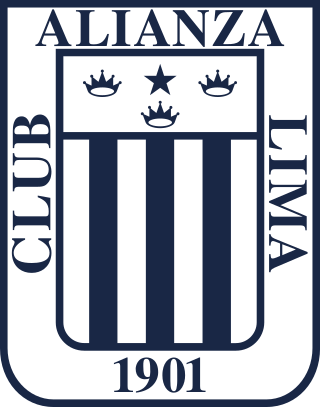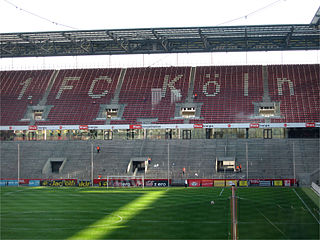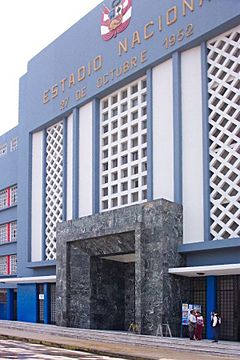
Ibrox Stadium is a football stadium on the south side of the River Clyde in the Ibrox area of Glasgow, Scotland. The home of Scottish Premiership team Rangers Football Club, Ibrox is the third largest football stadium in Scotland, with an all-seated capacity of 50,987. The stadium was designed by renowned football stadium architect Archibald Leitch, with renovations to the stadium between 1978 and 1981, as well as 1990 and 1991, being designed by The Miller Partnership and Gareth Hutchison respectively.

The Peru national football team represents Peru in men's international football. The national team has been organised, since 1927, by the Peruvian Football Federation (FPF). The FPF constitutes one of the ten members of FIFA's South American Football Confederation (CONMEBOL). Peru has won the Copa América twice, and has qualified for the FIFA World Cup five times ; the team also participated in the 1936 Olympic football competition and has reached the semi-finals of the CONCACAF Gold Cup. The team plays most of its home matches at the Estadio Nacional in Lima, the country's capital.

Football hooliganism, also known as soccer hooliganism, football rioting or soccer rioting, constitutes violence and other destructive behaviors perpetrated by spectators at association football events. Football hooliganism typically involves conflict between pseudo-tribes, formed to intimidate and attack supporters of other teams. Certain clubs have long-standing rivalries with other clubs and hooliganism associated with matches between them can be more severe. An example of this is the Devon Derby . Conflict may arise at any point, before, during or after matches and occasionally outside of game situations. Participants often select locations away from stadiums to avoid arrest by the police, but conflict can also erupt spontaneously inside the stadium or in the surrounding streets. In extreme cases, hooligans, police and bystanders have been killed, and riot police have intervened. Hooligan-led violence has been called "aggro" and "bovver".

Club Alianza Lima, is a Peruvian professional sports club based in La Victoria District of Lima, Peru. The club was founded under the name of Sport Alianza on 15 February 1901 by working-class youth in the Chacaritas neighborhood of Lima. It is widely known for having one of the most historical and successful football teams in Peru; they have won a total of 21 official league titles of the Peruvian Primera División and are currently the oldest team playing in that competition, since the club was founded in 1901. According to CONMEBOL, it is considered the second most popular club in Peru with more than 12 million fans as of April 2016.

The National Stadium of Peru is a multi-purpose stadium located in Lima, Peru. Its current capacity is 50,086 seats as stated by the Peruvian Football Federation without the lodges for some thousands more. The stadium was first inaugurated on 27 October 1952 for the 1953 South American Championship—replacing the Stadium Nacional—and is Peru's principal and national stadium. It has hosted three of the six South American Championship/Copa América football competitions held in Peru. It is referred to as the Coloso de José Díaz because of its proximity to a street of the same name. It is the home ground of the Peru national football team. The IPD —a branch of the Ministry of Education—is the stadium's administrating entity. The stadium has undergone several renovations for tournaments such as the 2004 Copa América. The artificial turf was installed for the 2005 FIFA U-17 World Championship. The most recent renovation started in 2010 and concluded in 2011. The re-inauguration ceremony of the renovated stadium was held on 24 July 2011 with a match between the Peru national under-20 football team and the Spain national under-20 football team.

Club Cienciano, more commonly known as Cienciano, is a Peruvian professional football club based in Cusco, that currently plays in the Peruvian Primera División. The club plays their home games at Estadio Garcilaso which has a capacity of 45,000. The club shares the stadium with other clubs from Cusco, Cusco FC and Deportivo Garcilaso.
The South American (CONMEBOL) zone of qualification for the 1990 FIFA World Cup saw 9 teams competing for 2 direct places at the finals, with one extra place potentially on offer to the winner of a play-off. CONMEBOL member Argentina qualified automatically as reigning World Cup champions.

The Alejandro Villanueva Stadium, popularly known as Matute, is a football stadium located in the Matute neighborhood of the La Victoria district in Lima, Peru. The venue is owned by Club Alianza Lima, and it is here that the club plays at home in the Peruvian Liga 1, and in international tournaments such as the Conmebol Libertadores or the Conmebol Sudamericana.

The football competition at the 1964 Summer Olympics started on 11 October and ended on 23 October. Only one event, the men's tournament, was contested. The tournament features 14 men's national teams from six continental confederations. The 14 teams are drawn into two groups of four and two groups of three and each group plays a round-robin tournament. At the end of the group stage, the top two teams advanced to the knockout stage, beginning with the quarter-finals and culminating with the gold medal match at the Olympic Stadium on 23 October 1964. There was also three consolation matches played by losing quarter-finalists. The winner of these matches placed fifth in the tournament.
The Accra Sport Stadium disaster occurred at the Ohene Djan Stadium in Accra, Ghana, on 9 May 2001. It killed 126 people, making it the worst stadium disaster to have ever taken place in Africa. It is also the third-deadliest disaster in the history of association football behind the Estadio Nacional and Kanjuruhan Stadium disasters.
The Ellis Park Stadium disaster was a crowd crush that occurred on 11 April 2001, claiming the lives of 43 people. Surpassing the Oppenheimer Stadium disaster, it became the worst sporting accident in South African history. Spectators poured into the Ellis Park Stadium in the city of Johannesburg, Gauteng, South Africa, for the local Soweto derby association football match between Kaizer Chiefs and Orlando Pirates. There was a 60,000 capacity crowd in the stadium, but reports suggest a further 30,000 more fans were trying to gain entry to the stadium. Reports also suggest that 120,000 fans were admitted into the stadium. An Orlando Pirates equaliser sparked a further surge by the fans trying to gain entry as they scrambled to see what had happened. The match was stopped after approximately 34 minutes of play when authorities received an unusually high volume of reported injuries.
The Luzhniki disaster was a deadly crowd crush that took place at the Grand Sports Arena of the Central Lenin Stadium in Moscow during the 1982–83 UEFA Cup match between FC Spartak Moscow and HFC Haarlem on 20 October 1982. According to the official enquiry, 66 FC Spartak Moscow fans, mostly adolescents, died in the crush, which made it Russia's worst sporting disaster. The number of fatalities in this crush was not officially revealed until seven years later, in 1989. Until then, this figure varied in press reports from 3 to 340 fatalities. The circumstances of this disaster are similar to those of the second Ibrox disaster in Scotland.

Estádio do Marítimo is a football stadium in Funchal, Portugal. It is the home stadium of Club Sport Marítimo and although much larger in its heyday, the stadium can now hold 10,932 spectators.

A terrace or terracing in sporting terms refers to the standing area of a sports stadium, particularly in the United Kingdom and Republic of Ireland. It is a series of concrete steps, with intermittent safety barriers installed at specific locations to prevent an excessive movement of people down its slope.

The original Estadio Nacional del Perú, originally known as Estadio Guadalupe, was a stadium that existed from July 18, 1897 until 1951 when it began, on the same land, the construction of Peru's current National Stadium. From 1921 this place was called Sports National Stadium since it was established as the main sports arena for the practice of football in Peru.

The 1971 Ibrox disaster, also known as the Second Ibrox Disaster, was a crush among the crowd at an Old Firm football game, which led to 66 deaths and more than 200 injuries. It happened on 2 January 1971 in an exit stairway at Ibrox Park in Glasgow, Scotland. It was the worst football disaster until the Bradford City stadium fire in Bradford, England, in 1985. This was followed by 97 deaths in the Hillsborough disaster in Sheffield, England, in 1989.
The South American section of the 2018 FIFA World Cup qualification acted as qualifiers for the 2018 FIFA World Cup held in Russia, for national teams which are members of the South American Football Confederation (CONMEBOL). A total of 4.5 slots in the final tournament were available for CONMEBOL teams.

The 2019 Copa Libertadores final was the final match which decided the winner of the 2019 Copa Libertadores, the 60th edition of the Copa Libertadores, South American's top-tier continental club football tournament organized by CONMEBOL.
A crowd crush occurred in the Los Olivos District of Lima, Peru on 22 August 2020, killing at least thirteen and injuring six others. The crush was a result of a raid by the National Police of Peru on the Thomas Restobar nightclub to break up an illegal gathering amid the COVID-19 pandemic in Peru.

On 1 October 2022, a fatal human crush occurred following an association football match at Kanjuruhan Stadium in Malang Regency, East Java, Indonesia. Following a loss by home side Arema to rivals Persebaya Surabaya, around 3,000 Arema supporters invaded the pitch. Police said the rioting supporters attacked the players and the team officials. The police attempted to protect the players and stop the riot but the crowds clashed with the security forces. In response, riot police units deployed tear gas, which triggered a stampede of people in the stadium trying to escape from the effects of the gas. A crush formed at an exit, resulting in fans being asphyxiated.














